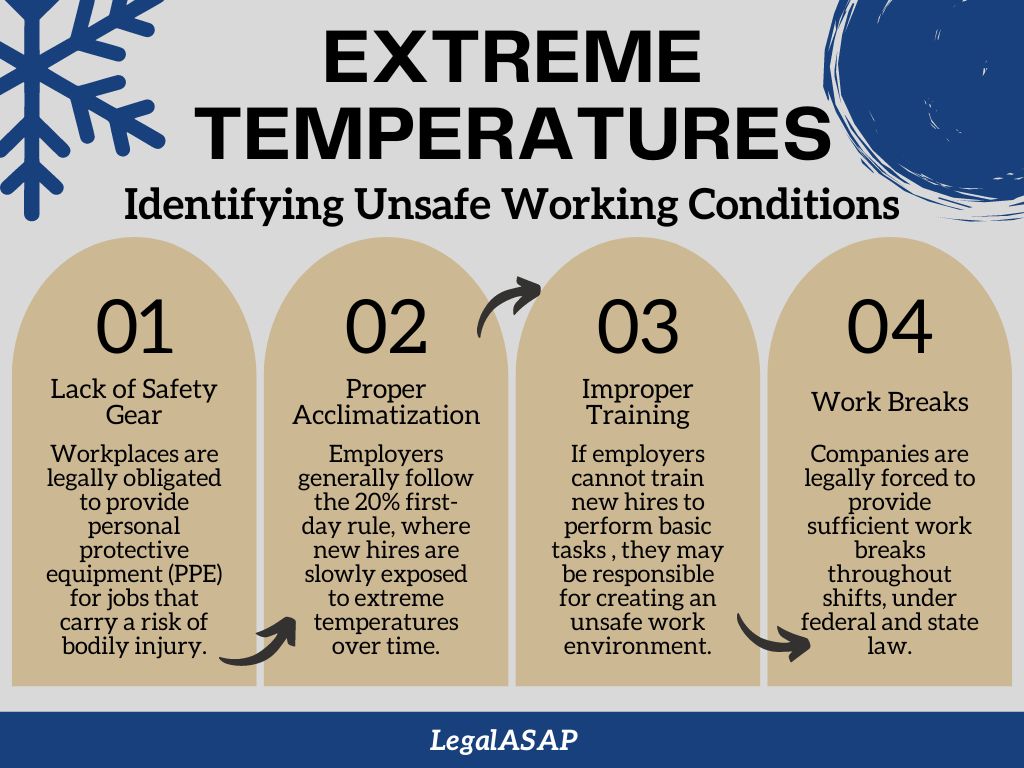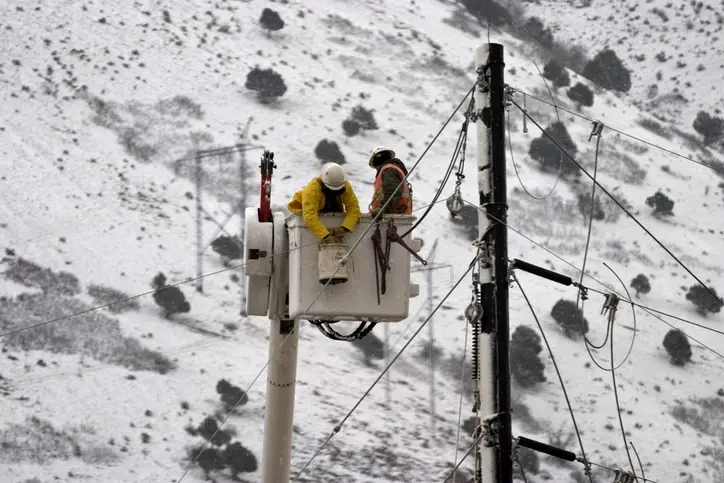There are no federal statutes detailing what temperature you can legally leave work to prevent heat and cold injury. Even so, there are federal and state worker rights protecting you from dangerous work environments. Depending on your state, employers are required to keep the workplace free of known health and safety hazards.
The Occupational Safety and Health Administration (OSHA) enforces rules to prevent employees from working in treacherous heat and cold temperatures. Failure to abide by OSHA’s health and safety regulations may result in penalties and fines for neglecting employees’ safety.
(a) Each employer –
(1) shall furnish to each of his employees employment and a place of employment which are free from recognized hazards that are causing or are likely to cause death or serious physical harm to his employees;
-General Duty Clause, Section 5(a)(1)
Employers must provide proper personal protective equipment (PPE) on the job if you find yourself under extreme heat and cold conditions. If your working conditions cause severe bodily injury to you or others, your employer may not retaliate against you for leaving the job site.
If you were injured at work due to extreme temperatures at your workplace, you may qualify for workers’ compensation benefits. In order to maximize your settlement, it’s vital to speak with a workers’ compensation attorney about your injuries.
Free Workers' Comp Evaluation
Have medical bills from a work injury? Click here to speak with a nearby attorney for FREE about your Workers' Compensation claim.
or call (888)-927-3080

Does OSHA Know What Temperature You Can Legally Leave Work?
OSHA cannot tell you what specific temperature you can legally leave work, but they can enforce labor laws for employees to operate in healthy and safe work conditions.
One worker may consider a certain temperature comforting while the other struggles to work consistently in that environment. Employers cannot federally enforce one mandated temperature for all workplaces in the state. However, state OSHA plans vary in coverage and scope, and they may apply to your case.
If the temperature in your job poses an immediate health risk, you properly alerted your employer, and they refuse to take further precautions, you have the right to refuse the work. If the employer retaliates against you, contact OSHA and an employment attorney immediately to consider legal action.
Working Under Extreme Heat

Employees need time to adapt when working in extreme heat conditions. Employers may prevent heat-related illnesses by using acclimatization to help new employees gradually grow accustomed to higher temperatures.
The National Institute for Occupational Safety & Health (NIOSH) and OSHA suggest the 20 percent rule for building heat tolerance.
The 20 percent first-day rule is for new workers to only work 20% of their shift under hot temperatures for their first day on the job. Then 20% more exposure is added each additional day until the employee performs a regular schedule.
Jobs that require you to work in extreme heat conditions are at risk for heat-related illnesses, especially for those:
- 65 years or older
- Overweight
- Have heart disease or high blood pressure
- Take medications that are affected in high-heat situations
Employers must provide the necessary PPE and training for employees to understand the potential dangers and how it affects their health and safety.
Working Under Extreme Cold

Working under extreme cold conditions requires employers to prepare workers for winter weather-related hazards. These include:
- Training Workers—Understanding cold stress and how to recognize its symptoms while monitoring yourself and your team. Workers need to know how to react in an emergency when calling for medical help or applying first aid.
- Supply Engineering Controls—Supplying equipment to protect workers from extreme cold, like radiant heaters to warm outside areas. Another example is aerial lifts or ladders to apply de-icing materials on roofs or prevent hazardous falls.
- Enforce Safe Work Practices—Applying proper tools/equipment and scheduling jobs at better times during less risky days. Employers should monitor weather conditions, have reliable means of communication, and be able to stop work and evacuate employees when necessary.
- Consider Protective Clothing—Employers must provide winter gear for employees to stay warm, and PPE to protect from falls or any hazardous accidents.
- Safety Tips for Workers—Employers should teach workers how to stay safe and monitor their health, like drinking warm liquids, keeping extra clothing, staying dry in the cold to prevent heat loss, etc.
It’s possible to catch cold-induced illnesses and injuries if employers don’t properly prepare their workers. The risk of heat escaping the body and causing cold-induced illnesses will occur without warm safety gear.
Heat Stress Disorders
Some heat stress disorders or illnesses an employee can suffer when working in extreme heat conditions are:
- Heat Stroke—a serious heat illness that occurs when the body cannot cool down and your body exceeds 103 degrees. Signs of heat stroke are confusion, unconsciousness, seizures, heavy sweating and hot dry skin, and rapid heart rate.
- Heat Exhaustion—the body overheats with symptoms of heavy sweating and rapid pulse rate, fatigue, muscle cramps, nausea/vomiting, and dizziness.
- Heat Cramps—physical pain during strenuous activities in hot environments where the body reacts with muscle spasms.
- Heat Syncope—feeling faint or light-headed when standing for long hours or staying in one position for a while.
- Heat Rash—occurs when your sweat glands become blocked and may cause itchy red bumps and blisters.
- Rhabdomyolysis—a harmful medical condition that can be fatal or result in disability when damaged muscle tissues release electrolytes and proteins into the blood and can damage the heart or kidneys.
Employers and workers should be familiar with heat symptoms to prevent heat illnesses during heated work environments. Seek a doctor immediately if you have any of the above symptoms.
Cold Stress Disorders
Common cold stress disorders when working in freezing environments are:
- Hypothermia—a serious medical condition when the body loses heat faster than it can produce, causing the body temperatures to drop below 95°F. Symptoms include shivering, disorientation, slurred speech, slow breathing, and fading consciousness.
- Frostbite—an injury caused by skin and deeper tissues freezing to cold environments, often found on hands and feet. Severe cases of frostbite may run deep enough to require amputation.
- Trench Foot—caused by long exposure to wet and freezing temperatures. This can lead to skin and tissue breakage, increasing the risk of infection. Symptoms include redness of the skin, leg cramps, blisters/ulcers, bleeding under the skin, and gangrene.
- Chilblain—damaging inflammation of small blood vessels in the skin induced by repeated exposure to above-freezing temperatures as high as 60 degrees. Symptoms are redness, itching, ulceration, and blistering.
Cold stress disorders can be prevented with proper safety wear while at work. Employers should provide safety gear and equipment while ensuring workers have regular breaks to retreat to warmer temperatures.
What are Heat-Related Emergencies?
Heat-related emergencies or illnesses are caused during extreme heat environments, which may lead to:
- Heat stroke and exhaustion
- Heat syncope
- Intense cramps
- Rash
- Rhabdomyolysis
Heat emergencies can happen to anyone, especially employees working outside under hot weather. A construction worker could have heat stroke by working above 106 degrees for a long period without any breaks. An industrial worker could lift heavy equipment in a heated warehouse and get heat cramps.
It’s important to provide workers with the necessary tools when working under severe temperatures. If you are feeling any symptoms of heat-related illnesses, seek medical attention to avoid any heat disorders.
How Can Employers Reduce Heat-Related Emergencies?
Here are ways for employers to reduce heat-related emergencies.
- Training: Educate all employees on the fundamentals of heat emergencies and illnesses and how to prevent them.
- Water: Provide enough fluids for workers and encourage them to drink 1 quart per hour or four 8oz glasses of water per hour as advised by the CDC.
- Shade: Provide access to shade, making sure employees take well-rested breaks and cool down. Don’t allow them to wait until fatigued to take breaks, but do so regularly.
- Planning: Develop plans that follow OSHA’s procedures for preventing heat-related emergencies. For instance, choose days to work when the temperature is not too hot. This prevents workers from legally leaving work during extreme temperatures.
If workers catch symptoms of heat-related illnesses, employers could have workers lie down in a shaded area and apply a cold compress. Call 911 if workers show signs of heat disorders.
Can You Sue Your Employer for a Heat-Related Work Injury?
You have the right to sue your employer for a heat-related injury even while receiving workers’ compensation. The employer can be penalized and fined for negligence for not abiding by OSHA’s heat regulations. Find an experienced workers’ comp attorney to help you file a claim and get compensated for your pain and suffering.
Defend Your Rights With a Workers’ Comp Attorney
Each state varies on what temperature you can legally leave work, but none can force you to work under deadly working conditions. If you were hurt due to severe heat or cold environments, a workers’ comp attorney can help you understand what benefits you’re owed.
LegalASAP can help you defend your rights by helping you find a workers’ comp attorney. We have over 500+ firms across the United States connected with thousands of experienced attorneys who can help with your claim.
Start filling out this free short evaluation form, and we’ll try to reach you as soon as possible. For questions or concerns that cannot wait, you may call our 24/7 hotline at 888-927-3080.
Cassandra Nguy
Cassandra Tran Nguy is a legal writer living in Los Angeles, California. She graduated cum laude from California State University, Northridge with a B.A. in English Creative Writing and a minor in Marketing. Visit her online profile at linkedin.com


